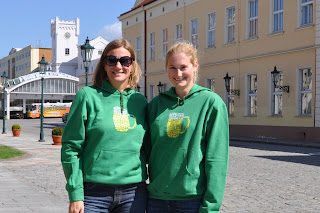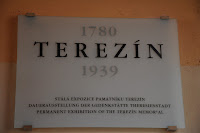I am a nerd. As I explained to my Czech students, I am like Sheldon and Leonard from The Big Bang Theory, when it comes to history, reading, and writing...basically when it comes to anything that involves learning. I am a learning nerd and I love learning about history. For me, to actually be in Europe and visit places where WW2 and other historical events took place, is such a learning opportunity for me.
I didn´t even realize how involved the Czech Republic was in WW2. As a previous junior high history teacher, I have never taught about the Czechś involvment. I didn´t even learn myself until I went to the Holocaust Museum in Washington D.C., and saw all the information regarding WW2 and the Czech Republic.
On Monday April 4th, when I was offered the chance to go to Terezin adn Lidice, I quickly said yes. I feel weird being "excited" about going to a concentration camp and "excited" definitely is not the right word, unless you think of it as being "excited" to learn and "see" history. The history nerd inside was eager to emerge.
I strongly believe God (universe) knew I was going to a depressing place because the weather absolutely reflected the mood of the trip. It rained (as Czechś say: it rained wheel barrows) all morning while we were at Terezin. Terezin is a concentration camp which is about one hour outside of Prague. The camp was a transition camp where prisoners waited to be sent to death camps. Also very interesting and quite morbid was that the Nazis created propaganda videos showing Terezin as a "resort" location and filmed Nazis, pretending to be jews, as having fun, watching movies, eating dinner together, etc. The Nazis showed these films to the Red Cross so that they could "see what great places concentration camps are." Obviously we know that was extremely farther from the truth.

We toured the fortress that was built in the 18th century during the fortification period then used as a concentration camp. Since I was with a group of French students/teachers, our tour guide spoke in French. Luckily my friend Mirek (French teacher) could speak English so he would translate. There was also an English speaking tour behind us, so I would sometimes separate from our group to hang back and listen to the English group. This was probably the first time in my life I have spoken three languages in one day. I spoke my high school level forgetting French to the students, Czech to my colleagues, and obviously English whenever I could.


In the first section of the camp we toured, we entered the infamous
Arbeit Macht Frei went into a sleeping area. On the left and right there was each a room that 100 Russians slept in on bunks. In the middle was a very small room with no bunks and that is where the Jews were put. Next, we were taken to the disinfection area where all the clothes were "washed" and the prisoners showered. We saw the shooting gallery area and the execution wall. Farther into the camp we camp to the "nice area" where the videos were created. This area of camp was for the soldiers and their families and no jews were allowed to go in. Some prisoners were kept there and if they were, they were lucky (as horrible as it is to say that). There was a movie theater, mess hall, swimming pool... Finally we came to the sleeping area that housed the most prisoners. In one huge room, there were about 600 prisoners that slept together and had one small box of a closet for a bathroom. Across from there was more sleeping areas. This area had to be built later because there was not enough places to put people. As you can see in the picture that the building was not very high...just about 6 feet high. Inside there were many rooms with a single wooden bed.
 |
| Execution wall |
 |
| showers |
 |
| shooting gallery |
 |
| where 600 people slept. There are bunks on both sides of the room |
 |
| the one bathroom for 600 people. There is no toilet inside that closet FYI |
 |
| the single dorms |
 |
| single dorms |
 |
| a room in the single dorms |
 |
| The "nice" area. There is a swimming pool and movie theater on the left of the picture |
 |
| The graveyard |
After Terezin we went to the small town, Lidice, except Lidice does not really exist anymore. The original town does not exist anymore, but they have created a new town with the same name. In 1942 the Germans completely destroyed the town. Before going here, sadly I had never even heard of the name or of the events that happened in this small place. The town has such a sad story and, for me, this place is probably one of the places that I will remember the most from all the places I have visited while in Europe.
In May 1942, SS Leader,
Reinhard Heydrich was put in charge in Prague. He announced his plans to erase everything "Czech" and make everything German. He wanted to ship all Czechs out or to make them slaves and make Moravia and Bohemia completely German. In June, shortly after coming to power, two Czech resistance fighters parachuted into Prague and assisinated Heydrich.


Immediately Nazis began searching for the two men, but with no luck. They searched village after village and no one had any information. For some reason (some believe because of the location) they decided to eradicate a small town called Lidice. This small town is about an hour outside of Prague and they wanted every reminder, including the name of the town to be forgotten. This retaliation for the assisination of Heydrich was to be a lesson to all those thinking of performing future attempts. No one in the town had any connection to the two parachuters, but yet they were used as the example. The Germans used explosives to destroy every building, house, farm, etc and even dug up all coffins so that NOTHING was left from this town. When they arrived, the rounded all the women and children under 15 and shot every man that lived in the town. The 184 women were sent to Ravensbruck and 82 children were executed. Seven children were selected to be "Germanized" and were sold to German families or sent to orphanges. Of the 17 suriving children, 9 were found and returned to Lidice. The women spent 3 years at Ravensbruck and then returned home. They were told that their children would be at the camp, but when they arrived the children were not there so they spent 3 years at the camp searching for their children and when they returned home. Like I said, only 9 survied and many of the surviving childrenś parents didn´t survive.
These were the German orders: concerning any village found to have harboured Heydrich's killers
Execute all adult men
Transport all women to a concentration camp
Gather the children suitable for Germanization, then place them in SS families
Burn down the village and level it entirely
 |
| 1st house in original town |
After the people were killed or sent away, the town was destroyed. The story reached a small town in Illinois and this small town changed their name to Lidice. Soon after, towns in Mexico, Brazil, UK changed their names to Lidice as well. Streets were named Lidice, even girls were given the name Lidice. The Nazis plan to erase all memories of Lidice back fired and the name was never forgotten. It is such an example of solidarity and compassion against evil for those towns to change their names, but I am so disappointed that our history books don´t talk about it. My own country was the first country to show support and I didn´t even know about it until I actually visited the real Lidice, Czech Republic.

The museum in Lidic is absolutely moving. You can see pictures, movie clips, and even read letters from children to their parents. After the museum, we toured the area where the town use to be. You can see part of the foundation of the ----------------- farm and the foundation of St. Martinś church. There are many sculptures made in memory, but the one that touched me the most was the sculpture of the school children.
It is an absolute atrosity for such innocent lives to be just destroyed. All the people in the town were innocent and had no knowledge of the assassination.
 |
| Horak's Farm |
The two parachuters were eventually identified after the destruction of the town...even though there were fake letters documenting that the parachuters were hiding in Lidice and that is why they destroyed it. Someone had snitched on the parachuters and they were found in Prague. Before the Nazis could capture them, the two parachuters commited suicide at a church in Prague so as to not die at the hands of the Nazis.
Statistics: 192 men over 16 killed in Lidice
105 children total: 81 were executed, 6 died in orphanges and 17 returned home
60 women were killed in camps
 |
| St. Martin's Church (the foundation shows the location) |
It was a long day and very draining, not only physically, but mentally as well. The faces of the victims (especially the precious childrens) stay with you and their sad story remains always in the fore front of your thoughts. I am so glad that I went and that I had the opportunity to learn about these events and places. I know I am going to be a better teacher because of what I saw and what I learned. I am going to be able to teach from a personal place that I would never had been able to do before. There is just so much to learn and appreciate about the Czech Republicś struggles and history. I am honored to be able to tell their stories.
Here is a link to find more information on Lidice:
http://www.ask.com/wiki/Lidice
Here is a link to find out more information about Terezin:
http://www.ask.com/wiki/Theresienstadt_concentration_camp


 The artist created a shield of arms in remembrance to the leaders of the time...completely made of bones. Behind the shield is one of 4 "boxes" piled high with human bones.
The artist created a shield of arms in remembrance to the leaders of the time...completely made of bones. Behind the shield is one of 4 "boxes" piled high with human bones. 


























































